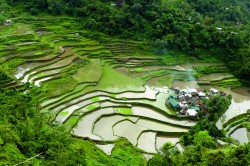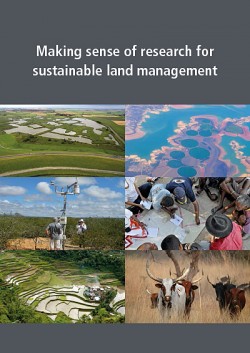Press Release, 05. December 2016
Making Sense of Research – Research for Practical Application in Land Management
Application-focused book with the findings of international research on sustainable land management presented at the global Convention on Biological Diversity (CBD)
According to the UN Convention to Combat Desertification, twelve million hectares of fertile, arable land is lost each and every year. Soils are suffering from aridization, salination and overuse. This means that the loss of soil fertility is one of the central challenges to society with regard to the management of natural resources. Solutions for more sustainable land use that not only takes into account the environment and existing ecosystems worldwide but also aspects of climate change are presented in the book "Making Sense of Research for Sustainable Land Management". It is published by the Helmholtz Centre for Environmental Research (UFZ) and the Centre for Development and Environment (CDE) of the University of Bern. This scientific volume will be presented today at the global Convention on Biological Diversity (CBD COP 13) being held in Cancun (Mexico) in a dedicated session as part of the Landscape Day.

Photo: Josef Settele

Photo: WOCAT
The book outlines land management practices that have been tested by researchers in twelve projects around the world within the scope of the "Sustainable Land Management" research programme. The programme was funded by the Federal Ministry of Education and Research (BMBF) over a seven-year period. The investigations involved related to the interaction between land use, climate change, loss of biodiversity, population growth, globalisation and urbanisation. The focus was placed on regions particularly exposed to global and local change such as climate change or fluctuations on the global market. These regions include steppes in Russia, tropical rainforests in Brazil, the landscape along the North and Baltic Sea coasts and forest and river landscapes in China and Vietnam. Some of the most serious effects are the loss of biodiversity, rapid deforestation with the associated soil erosion or flooding, and salination.
The examples seen in practice are as diverse as they are specific to each individual place. They include ecological engineering in rice farming in the Philippines, more sustainable cotton production in China, the deployment of non-tillage farming on large-scale farms in Siberia, coastal area management in northern Germany, improved subsistence farming in Madagascar, integrated management of river catchment areas and reservoirs used for hydropower and irrigation in Brazil and Vietnam, and as integrated land and water management concepts in the Okavango catchment area in Africa.
The book aspires to provide evidence-based research with a focus on implementation. This approach is intended to make it easier for scientific findings to find their way into practice. "Our objective is to acquire and pass on knowledge on the sustainable use of natural resources such as soil, vegetation and water within a changing climate and shifting political climate," explains Dr. Rima Mekdaschi Studer, one of the authors of the study and researcher at the CDE. As an example, one of the case studies shows how pastoralists in Madagascar are able to secure supplies of fodder for their grazing animals by using cuttings to reproduce a certain type of tree. In Brazil, on the other hand, researchers documented how organic material can be used to enrich the soil with carbon which increases fertility of the soil and helps to bind carbon dioxide.
The methods and recommendations contained in the book are based on the expertise of some 600 researchers and other individuals involved in local land management. "These are the result base on an intensive research in the regions but - even more important - a considerable number of meetings, joint events and discussions to identify practical relevant knowledge," explains co-author Dr. Peter Moll of the Moll&Zander consultancy team. The target groups and potential users include local initiatives, land owners and users, regional and national institutions, government representatives, businesspeople and NGOs. "Convincing findings that can be put into practice only come about when researchers see themselves as part of cross-functional teams from the realms of science and practice and when all participants are involved from the very start, whenever possible," Moll explains. This is an ongoing challenge for research, he adds.
The global WOCAT network (World Overview of Conservation Approaches and Technologies) has dedicated itself to the task of documenting and disseminating practical knowledge for land users. The network is based at the University of Bern’s CDE. "The book uses field measurements and modelling to illustrate the impact of specific forms of land use. In addition, various scenarios demonstrate the consequences of climate change and changes in land use - at a local and regional level," says co-author Dr. Hanspeter Liniger, responsible for WOCAT at the CDE. "This forms the basis for knowledge-based decisions," he continues. All in all, more than 30 implementation-focused examples have been compiled by the some 140 authors of the WOCAT book, which has been vividly illustrated with photos and diagrams. "The findings reflect the diversity of land use patterns, their benefits and disadvantages and the contribution from implementation-focused research," says Ute Zander of the Moll&Zander consultancy team.
The research findings from the twelve regional projects under the BMBF programme are brought together in the accompanying project GLUES (Global Assessment of Land Use Dynamics, Greenhouse Gas Emissions and Ecosystem Services), which is coordinated at the UFZ. "Most of all, the book serves to ensure that the findings from the research programme can be applied, and resonates with practice" says Prof. Dr. Ralf Seppelt, head of the UFZ Department of Landscape Ecology and GLUES project manager. The book is supplemented by a database and videos that present selected practical examples. "This makes it possible to communicate and implement innovative land management measures throughout many regions all over the world," explains Prof. Dr. Seppelt.
Publication
Liniger, HP., Mekdaschi Studer, R., Moll, P., Zander, U. 2017. Making sense of research for sustainable land management. Centre for Development and Environment (CDE), University of Bern, Switzerland and Helmholtz-Centre for Environmental Research GmbH - UFZ, Leipzig, Germany ISBN (print): 978-3-944280-99-8
Links:
Landscape Day, CBD COP13, 5.12.16: http://www.riopavilion.org/december-5th-opening/
Download or order book: www.ufz.de/makingsense or www.wocat.net/makingsense
More information on the GLUES project: http://modul-a.nachhaltiges-landmanagement.de/en/scientific-coordination-glues/
More information on the Sustainable Land Management funding programme: http://nachhaltiges-landmanagement.de/en/home/
More information on WOCAT: www.wocat.net
Further information
Prof. Dr. Ralf Seppelt
Head of the UFZ Department of Landscape Ecology
ralf.seppelt@ufz.de
Dr. Rima Mekdaschi Studer
Centre for Development and Environment (CDE), University of Bern, Switzerland
rima.mekdaschi_studer@cde.unibe.ch
Ute Zander
Learning processes for sustainable development
zander@lernprozesse.com
UFZ press office
Susanne Hufe
Phone: +49 341 6025-1630
presse@ufz.de
In the Helmholtz Centre for Environmental Research (UFZ), scientists conduct research into the causes and consequences of far-reaching environmental changes. Their areas of study cover water resources, ecosystems of the future, environmental technologies and biotechnologies, the effects of chemicals in the environment, modelling and social-scientific issues. The UFZ employs more than 1,100 staff at its sites in Leipzig, Halle and Magdeburg. It is funded by the Federal Government, Saxony and Saxony-Anhalt.
www.ufz.deThe Helmholtz Association contributes to solving major challenges facing society, science and the economy with top scientific achievements in six research fields: Energy; Earth and Environment; Health; Key Technologies; Matter; and Aeronautics, Space and Transport. With some 39,000 employees in 19 research centres, the Helmholtz Association is Germany’s largest scientific organisation.
www.helmholtz.de